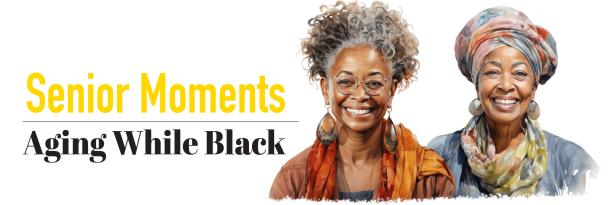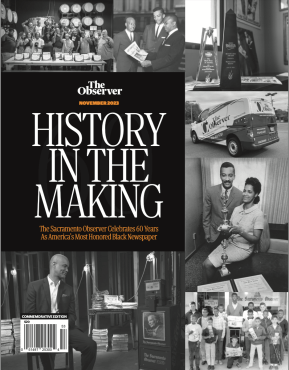By Genoa Barrow | OBSERVER Senior Staff Writer
The term “weathering” is used to describe the deterioration of Black people’s health that stems from the constant stress caused by continued racism and discrimination.
Black Americans have weathered many storms, but somehow have managed to look better than they’ve felt.
To quote lyrics from late rapper Tupac Shakur’s song “Keep Ya Head Up,” “Dying inside, but outside you’re looking fierce,” stress and continued health issues weigh heavily on a person and cause them to appear much older than they are. Defying this has long been explained with the simple response: “Black don’t crack.”
The protective melanin that gives Black people their mahogany hues and chocolate tones has been a cosmic consolation prize of sorts for the centuries of challenges that they’ve faced. Some say having a “Black don’t crack” mindset has helped some people sustain, while others say it’s a dangerous facade to maintain.
The OBSERVER recently sat down with women’s advocates Carlene Davis and Kiara Harris, co-founders of the group Sistahs Aging with Grace and Elegance, or SAGE, for a conversation about the realities of aging for Black women. Black may not crack, but Davis and Harris say cracks in the veneer can occur. The realities of aging, they say, can and do catch up to you.
“There was a study by the National Institutes of Health that found that Black women between the ages of 49 and 55 are biologically 71/2 years older than white women. A significant contributing factor to that is the effects of racism, weathering and bearing the burden of that strong Black woman trope or schema,” Davis says.
“Black may not crack, but there are definitely fissures,” she continues. “Whether it’s heart disease, cardiovascular disease, cancer, diabetes, kidney failure, hypertension, Alzheimer’s or other dementias, Black women are disproportionately impacted by chronic disease and comorbidities, and it’s not a new thing.”
Davis, who also works with the California Black Women’s Health Project, says change is a “longitudinal, ‘do more’ assignment.”
“That is a learning that needs to start happening as we are young,” she says. “This newer generation, they are much more intentional around setting boundaries. There are some potential downsides of that, but they are much more intentional around centering their own self-care first. It’s like putting on your oxygen mask first before you could take care of everyone else.”
Harris has had her own battles with illness. Lupus turned into kidney failure and she spent nine years on dialysis before a life-saving transplant.
She also had two strokes. “I was on dialysis three days a week. I could not earn money. I didn’t do much of anything,” she says. “When I got sick, with all my family being back on the East Coast, it was very, very scary.”
As a single woman with no family close by, things got rough. “I learned how to garden and I was growing some food in my backyard,” Harris says.
Davis and Harris bonded over similar struggles. Harris navigated her illnesses alone and, as an only child, the care of Davis’ ailing parents fell solely on her.
“After both of my parents became ancestors, I started thinking, ‘Wow, well, there’s no mini me’; as I age, there’s no one,” she says. “I don’t have sisters, I don’t have brothers. It became clear to me that I would need to start, one, thinking more intentionally around my aging journey and, two, that my support system would have to be created because I didn’t have the default support system, which generally is family.”
As professional women in their late 30s and mid 40s, they were thought to “have it all,” but the friends learned that the phrase “Sistahs are doing it for themselves” can be both mantra and manacle.
“When your health goes south, it’s a different story because you’re going to need some help,” Harris says.
The two started a conversation about what single women are supposed to do as they age. They also posed the question to other friends.
“They didn’t have the answers either,” Harris says. “We started Sisters Aging with Grace and Elegance out of those conversations. We started talking about strategies and what might be some of the things we can do. We even talked about building affordable housing.”
“My Sister’s House was going to be like a compound for single Black women who didn’t have children and weren’t married, to come together and create this community of support,” Davis recalls.
“I was at the redevelopment agency, so I saw affordable housing being developed everywhere,” Harris says. “There was senior housing for Asian communities. There was senior housing for Latino communities, but there really wasn’t anything specifically dedicated to Black people aging and needing some senior housing facilities. It does not exist.”
Rising property costs killed the idea, but they were on to something – exploring what successful aging looks like.
In 2022, AARP conducted a study of older single adults with no children that gauged their attitudes about life, health, and financial and social well-being. The study found that many older Americans living alone are generally happy, but worry about future health care needs and haven’t adequately prepared for them. Participants were most concerned about losing their independence and physical strength (78%), being in poor health (72%), and losing their memory (71%). They also frequently worry about financial insecurity, losing loved ones, being unable to afford care, and having to leave their homes.
Harris says California’s high cost of living can hit Black women hard.
“There’s a high rate of singlehood amongst older Black women as well, so there’s not two incomes to fall back on,” she points out.
SAGE categorizes people by age. There’s the Fabulous 40s, Phenomenal 50s, Sensual 60s, Sensational 70s, Elegant 80s and Naughty 90s.
“We are trying to create a wellness journey through every decade of our lives, so that we are both financially secure and healthy and living a satisfying life with all the support networks that you need,” Harris says.
SAGE has events and activities in Sacramento, the Bay Area and Los Angeles. Women attend sessions clamoring for discussion about health and relationships. Many have had to work past retirement age to stay afloat.
“Just because you’re older doesn’t mean that things stop going up in price,” Harris says. “If you don’t have some things in place as you age, if you are not walking around with health care insurance that is going to be pretty steady year after year, you’re in a vulnerable situation.”
Davis adds: “When we don’t acknowledge our vulnerabilities early, we end up in a crisis situation where it’s even harder to make it out of it.”
Black women must actively plan for their golden years, they say.
“Do you have a power of attorney? Do you have a will? Do you know what you’re going to do if you get sick and incapacitated? Do you know who’s going to be a caregiver for you, should you need one?” Harris says.
“We didn’t generally have those conversations,” Davis says of older generations. “You just came into it, and then when you got there, and there was a challenge, or whatever, you just jumped into action.”
With SAGE, the goal is to create a space for Black women to feel empowered to have these conversations with themselves and their family members.
We started out having these events called “Celebrating the Aging Journey” and that’s still one of our signature events,” Davis says. “During those convenings, we bring in content experts in areas that we should be thinking about.”
Session topics range from caregiving plans to protecting intergenerational wealth.
“Black folks lose a lot of their wealth to probate because they don’t have wills and trusts, so it ends up having a secondary impact as well,” Davis says.
Ten years ago, some ladies were hesitant to be associated with an aging group, but Davis says they’ve matured into the concept and now see that it is in fact for them
“Definitely, over time, the stigma around aging has reduced,” Davis says.
Back in 2007, the NAACP had a symbolic burial for the n-word, stating that use of the racial slur didn’t serve the Black community and needed to be laid to rest. While Davis doesn’t suggest doing the same for the term “Black don’t crack,” she does think it’s outdated.
“I think we should have a plaque for it somewhere,” she says. “What they’re essentially saying is that Black women are the mules of America and you wouldn’t wear that as a badge of honor, would you?”
Davis envisions a time when Black women return to their ancestral tradition of honoring aging as a collective rite of passage rather than an individual test of mettle.
“Our strength is a journey; it is a collective endeavor,” she says. “What I would say to ‘sage’ sisters is, don’t ever feel like you need to be on this journey alone.”
Genoa Barrow’s series, “Senior Moments: Aging While Black.” The series is being supported by the USC Annenberg Center for Health Journalism and is part of “Healing California,” a yearlong reporting Ethnic Media Collaborative venture with print, online and broadcast outlets across California. The OBSERVER is among the collaborative’s inaugural participants.






